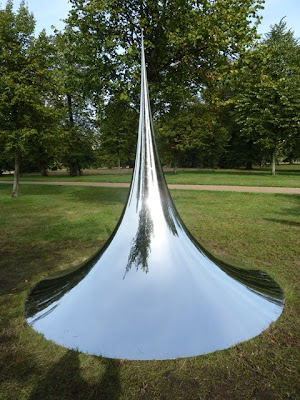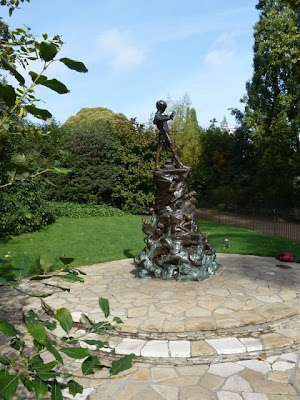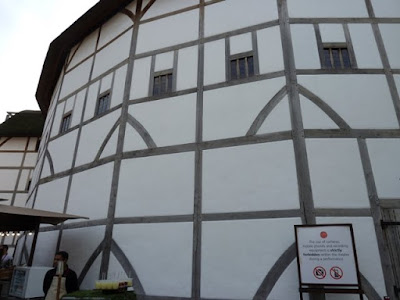Why, then's the world's mine oyster
Which I with sword will open.
(William Shakespeare, The Merry Wives of Windsor)

Well, I do have my ubiquitous Oyster Card in my bag to provide my means of public conveyance in London, and my sword is my camera and my trusted Moleskin notebook, and I have come to London one final time, mainly to see a Comedy at the Globe Theatre, but as a side-bar to pop into Kensington Gardens to see the mirrors!

These are the public sculptures of Anish Kapoor, whose aim is to
"Turn the World Upside-down."
This is the first time Kensington Gardens has been turned over to an artist for a modern installation, and Kapoor's use of mirrored sculpture has attracted considerable attention.
This is the one I most enjoy: this spire is entitled "Non-Object" and appears to float above the grass under the trees.

On the train this morning I read a short review in which Fisun Güner writes:
"Their presence is very much foreign in these lush surrounds but nonetheless engage with it to great effect."

The largest piece, "Sky Mirror" appears to be out of commission, with workers behind it fiddling with the machinery that causes it to move and catch and reflect the sky and Long Lake by which it stands.


"Sky Mirror" from the other side of Long Lake.

This is "C-Curve." The convex side reflects the trees and the viewers.

The concave side flips our world upside-down.


Unfortunately, "C-Curve" has now been surrounded by a security fence. There is duct-tape on one part of the convex side. These--oops--this workman had been Windexing the mirror on this side. Back at "Non-Object (Spire)" a security guard kept us a few feet away from the spire, although dog prints belied his skills as a dog-stopper.

"Sky Mirror Red" is in the pool in front of Kensington Palace.


In the British media there have been references to "Sky Mirror Red" reflected in the water with the swans, and one photo has the artist in front of it as a swan is swimming by, so I duplicate that photo--minus Anish Kapoor, sadly.


Whilst here, it seems worthwhile to visit the famous bronze of Peter Pan next to Long Lake.

I cannot claim any great familiarity with Peter Pan, except from the cinema, but everyone knows about Peter and Wendy and Tinker Bell, even if only from Walt Disney.

"So come with me where dreams are born, and time is never planned. Just think of happy things, and your heart will fly on wings, forever, in Never Never Land."

The bronze statue of The Boy Who Would Not Grow Up was created by Sir George Frampton (1860-1928) and was placed here--under mysterious circumstances!--in 1912. It was a gift from Sir Peter Barrie (1860-1937) the creator and author of Peter Pan. The plaque was unveiled in 1997 by Princess Margaret, Lady Snowdon, who lived nearby in Kensington Palace.

"When the first baby laughed for the first time, its laugh broke into a thousand pieces, and they all went skipping about, and that was the beginning of fairies."

"I'll teach you to jump on the wind's back, and away we'll go."

Just as the many birds in Kensington Gardens do!

Since I first toured the restored Globe Theatre in 2008, I knew I had to return to see a performance. I was too late this spring for Macbeth, so I chose The Merry Wives of Windsor, another favourite. And, of course, it had to be a matinee--of which there are not many--so three days before leaving the UK for good, I come to London to see Shakespeare.

I have written in previous blogs--see 2008--and have raved about how well done this replica is. The blending of what is perceived to be the original design with the requirements of modern theatre design is excellent.

The complex buzzes with the sounds of numerous groups of students--including one group of young women from Argentina--and I recall fondly my 36 years of teaching Shakespeare at Horton High School, in Greenwich near Wolfville, in Nova Scotia. I am first in the queue to be admitted to the North Tower and the Upper Gallery.

I had found a single seat on The Globe Website, and I think it has been a lucky find. I have a perfect view of the stage.

The Gentlemen's Gallery near the stage offers padded chairs, but I have rented a cushion and squeeze into my small space and wooden bench.


I have to lean forward just a little to see the additional staging. The rectangular piece flips over to reveal a garden and loveseat, and during intermission, a giant tree stump is attached to this side, for the scenes when the fairies dance around Falstaff in the forest.

You can see, in the bay next to the one I am in, that these benches require crowding in, but none of us seems to mind. And we have a railing we can rest our elbows upon, when we want to lean forward.


I could not resist invading this Japanese woman's privacy by taking this photo. I had seen her in the foyer, in full Japanese dress, on her own, and I still wonder how much she enjoyed the show. She smiled and laughed through the performance, so I think it was worth her while.

I don't think I could have been a groundling. They only paid £5 compared to my £35, but they had to stand from before 2:00 until the closing bows at 4:30. Besides, today most of them were students, and I saw several spend most of the performance texting.



Some young people paid a bit more for benches in the Lower Gallery. It is reassuring to see so many youth coming to see performances of Shakespeare.

I just noticed the "smokestack" of the Tate Modern Art Gallery next door, rising above "this Wooden O."

They were re-thatching The Globe when I was last here in October 2008. The bright green splotches makes me wonder about mould and whether this thatch will last the normal 15-25 years.

The show is about to begin. An actor comes forth to remind us that we must not take photos or use our cell phones, as the play would take us back to a time when "these have not yet been invented!"

At first I thought this might be one of the actors, as they made entrances from inside the theatre and from amongst the groundlings. Yet, she was just a princess by herself, over-dressed for the show. This was the only sunny day this week in London, and a gentle breeze wafted through the spectators. Pigeons dropped by to watch a few scenes. The only distractions from outside were a helicopter flying by and a jet overhead.

My choice seat is in the centre of the Upper Gallery. I come down during the break to take a few photos.

As The Merry Wives of Windsor is set to start, the wandering minstrels appear below. I snap a few photos before packing my camera away. The music was composed by Nigel Hess; choreography by Jenny Arnold.

It's time to settle down to enjoy the performance, but it is difficult to sit still because the energy of the production ripples through the audience, as we get caught up in the story of young lovers marrying for love and not to please parents, and of poor Ford masquerading as Brook in his attempt to prove Sir John Falstaff is making a cuckold of him by sleeping with Mistress Ford. Of course, the final revenge at midnight against Falstaff and the secret marrying of the young lovers is all worked out with hilarity, dancing and song.
"Marry, this is the short and the long of it; you have brought her into such a canaries as 'tis wonderful!" (Mistress Quickly)

I take out my camera again for the final "curtain calls" as lively and humourous as the play.

Young Anne Page--played by Ceri-Lynn Cissone--and her true love, Fenton--acted by Gerard McCarthy. The play was directed by Christopher Luscombe. I thought the costumes were also excellent.

The parents of Anne Page, foiled in their attempts to marry their daughter to a suitor each one had picked. George Page performed by Michael Garner, and Meg Page by Selena Evans.

Of course, thunderous applause comes for Sir John Falstaff, performed wonderfully by Christopher Benjamin, who seemed ideally cast for the part of the fat old knight. And the play ends, thoroughly enjoyed by the audience, with these words from Mrs. Page, now accepting that there is no remedy for her daughter's marriage, and gleeful about the revenge the merry wives have played on Sir John:
"Let us every one go home,
And laugh this sport o'er a country fire!"

I must head home, too, and call my squire to bring me my steed.
Well, actually, I cross the Millennium Bridge, and pause by this brand new statue at St Paul's Cathedral.


I used the metaphor of closing doors in my last blog about Oxford, so carry it on here as I look at the great doors of St Paul's. In a few moments I will descend into St Paul's Underground, go to Oxford Circus, where the "change here" call puts me on the Bakerloo Line to Marylebone, where, without seeing anything of the city again, I'll board the train home to Caversfield, a very satisfied gazer at mirrors and Merry Wives.

My Farewell (below) as the door closes on London and on my blog, of which this is Number Seventy-One.

It is hard not to speak with worn-out phrases and fading superlatives, but when I follow the Queen's Walk along the Thames, especially in stretches like Southwark or Bankside, or along the old docks of the London Pool, it is not difficult to close my eyes and imagine I see the tall clippers and then hear the voices of dock workers and publicans and sailors--the sounds of commerce on the river and along the shores that support it.
I imagine that I can hear the actors rehearsing their parts for the stage of The Globe and the growling of dogs and the terrified cries of the bears in the baiting pits.
I can hear the bells of the churches, perhaps from Mary-le-Bow Church across the Thames. I listen to the sounds of carriages and carts and the hooves of the horses on cobblestones. I can imagine the sounds of London over all the centuries.
The London I have visited today and so many times for three years is a very new London, much of it redeveloped in the past twenty years. I can recall bits and pieces from the week I spent here as a boy in 1965: I liked it then and I love it now, feeling that I am starting to know her better.
The old London is still here--the Globe restored--iconic landmarks bustling with tourists--old St Paul's, the great survivor of wartime Britain now looking down on gleaming office buildings and surrounded by well-dressed modern professionals--and, yes, yes, more tourists. The London Eye still flies, Big Ben booms at noon, and the flowers always bloom in Queen Mary's Gardens. The ravages of the Blitz barely show now, and the poverty and slums of places like the East End are gone--along with the Cockneys--and the people represent all accents on earth, making it a wonderful place in which to listen--to the new sounds of London.
There's a lopsided old pub, propped up by modern buildings either side, and peeking up over the ancient Tower of London is that silly Gherkin. The old Bankside Power Plant is now an amazing modern at gallery. And I can walk one last time across an aluminum and steel pathway marking the most recent London Millennium--across The River Thames as people have done for centuries.
Sometimes I have to scrunch up my eyes and plug my ears to the noises of modern traffic to imagine it, but the Old and the New live side by side and the city hums with growth and development as the ancient Thames sighs in and out as it has done--and will do--forever.
Have I caught thee, my heavenly jewel? Why, now, let me die, for I have lived long enough: this is the period of my ambition: O this blessed hour!
(John Falstaff, The Merry Wives of Windsor)
